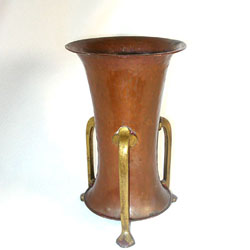Copperton Lane: Specializing in Antique to Mid-Century Copper Items
 Hammered copper tea kettle.
Hammered copper tea kettle. Photograph courtesy of Teri Rosvall
It all started with the three Jell-o molds Teri Rosvall received as a wedding gift.
"I thought they were copper but were simply copper-colored anodized aluminum with no actual copper content,” she recalls. “I had put up paper on my wall with illustrations of copper kitchenware. The Jell-o molds looked so nice on that paper that I went looking for more 'copper.' That's when I realized the real metal is much more beautiful than the wanna-bes."
Today, she still has those molds hanging on her office wall and her collection has grown into a thriving business, Copperton Lane Antiques and Collectibles, where she collects and sells her unique copper finds to customers all over the globe.
"I love the beauty and warmth created in rooms decorated with copper," says Rosvall, whose eye is drawn to "pieces that speak to me. Pots and vases from any era abound though ice cube trays, soap graters, kitchen appliances and unusual items normally produced in more common metals are especially attractive. Since I purchase at estate and on-site auctions, I usually don't have any provenance. I try to find out about the history of pieces for myself (and collectors) when available. I wonder about the people who made and used them. However, after all these years collecting and selling, I'm usually able to determine the origin or maker accurately."
Her primitive, hammered copper water/tea kettle of heavy solid copper with a bronze handle is probably 200 years old. A small copper pan with a long wooden handle looks like it could be a bedwarmer, yet is actually a Victorian era fireplace chestnut/bean warmer. Made in France, the hinged lid is reticulated with round and arrow shaped piercings. The covered pan has an applied bronze medallion of the city of Chambray in its center. Rim and lower edge are dented. The interior reveals heat marks from hot coals, though not excessive.
 Copper Vase
Copper Vase Photograph courtesy of Teri Rosvall
"A child-size Turkish coffee set I purchased at a Seattle flea market in the 1980s includes an embossed tray, a pot with pour spout, no-handle 1 3/4" high cup and 3 3/4" saucer made of solid, lightweight copper. It was most likely made in the 1960s," Rosvall estimates.
"Uncommon objects from the Arts and Crafts era are harder to find. I collect them, too, although they tend to be typical desk/decor items like vases, bowls, bookends, ashtrays, pitchers, planters and candlesticks. A Craftsman Studios hammered and folded copper pod console or flower planter comes in various sizes. Though the previous owner liked the shiny exterior and kept it well-polished, the inside has a water line near the rim with slight verdigris. A transitional crumb catcher from Craftsman Studios in Laguna Beach, California, evidences transitional progression from Mission Arts and Crafts to the Art Deco period because of its square, stair-stepped construction," Rosvall reports.
An expert on caring for the metal, Rosvall also gives various tips on her website regarding removal of lacquer from U.S. kitchenware sold in the last 30 to 40 years and how to polish/clean non-lacquered pieces. She advises that "the passage of time is the only thing that will restore a true patina to copper." She mentions unlined kitchen items that should not be used for cooking and says, "Copper is an excellent conductor of heat. That, combined with its beauty, is why copper cookware is so popular."
Since Rosvall began selling over the internet in 1988, she has shipped more than 10,000 packages all over the world.
"I'm currently acquiring numerous small vintage appliances,” she says. “I have blenders, lighting, clothes irons, heaters, deep fryers, percolators, mixers and even a hair dryer, but still no copper telephone."
Resources:
Also in this Issue:
- Continuing the Copper Legacy of Roycroft
- Bringing New Life to Early Culinary Copper
- The Lure of Curiously Historic Coins Minted from Copper
- Copperton Lane: Specializing in Antique to Mid-Century Copper Items
- Princeton University of Art Unveils Monumental Bronze Sculptures by Ai Weiwei
